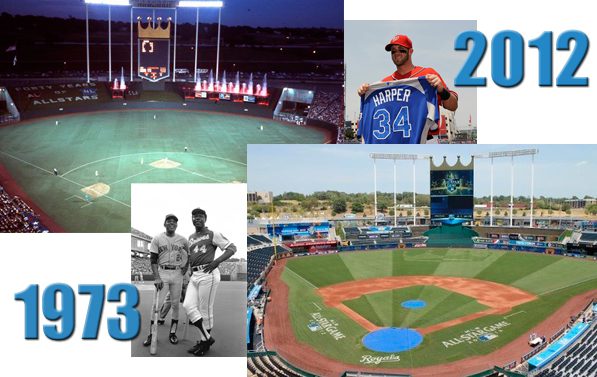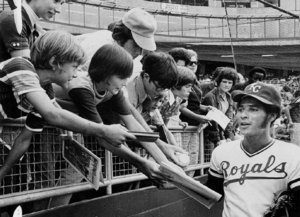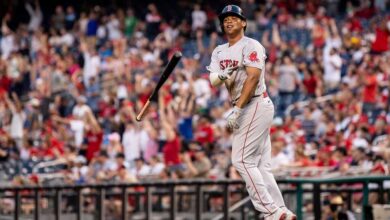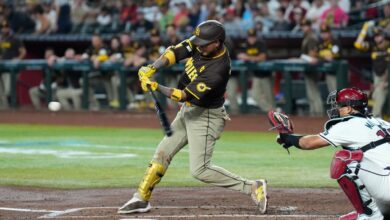
 It was the year of a major oil crisis, as the Yom Kippur War engulfed the Middle East. Televised hearings began regarding the Watergate break-in, just as the Nixon administration announced troop withdrawal from Vietnam. In a landmark decision by the U.S. Supreme Court, Roe v. Wade was overturned. And On September 20, Bobby Riggs lost the “Battle of the Sexes” tennis match to Billie Jean King, 6-4, 6-3, 6-3.
It was the year of a major oil crisis, as the Yom Kippur War engulfed the Middle East. Televised hearings began regarding the Watergate break-in, just as the Nixon administration announced troop withdrawal from Vietnam. In a landmark decision by the U.S. Supreme Court, Roe v. Wade was overturned. And On September 20, Bobby Riggs lost the “Battle of the Sexes” tennis match to Billie Jean King, 6-4, 6-3, 6-3.
In baseball, 1973 was the dawn of a new era with the birth of the designated hitter. Yogi told us that “It ‘ain’t over ‘til it’s over”, and it wasn’t, as his Miracle Mets won the Pennant. A group led by a Cleveland shipbuilder named George M. Steinbrenner III, purchased a once proud franchise from CBS for $10 million. An African-American faced bigotry and racism as he pursued one of baseball’s most sacred records. And an aging icon, whose career was just about to end, said it was time to “Say goodbye to America.”
2012 marks the third time an All-Star Game will be played in Kansas City. It is the first since ’73.
The first time KC hosted an All-Star Game was in 1960, at old Municipal Stadium. The National League defeated the American League, 5-3. Starting pitcher Bob Friend of the Pirates got the win, backed by homers from Mr. Cub, Ernie Banks, and Milwaukee Braves catcher Del Crandall. Bill Monbouquette, who would throw a no-hitter for the Red Sox in 1962, took the loss for the American League.
It was the second All-Star Game of the season, as between 1959 and 1962, major league ballplayers sought to add more money to their retirement pension fund. No All-Star MVP’s were chosen, as the award was not given out until ’62.
The ’73 contest was played on July 24 in front of a sellout crowd of 40,849. Royals Stadium, as it was known then, was a brand new ballpark, having opened its doors just three months earlier in April. It featured gigantic fountains and waterfalls in right field, known as the “Water Spectacular”, and the Plaza, which is still lined with stores and restaurants today. The 322-foot wide Water Spectacular began operating a week before the game and is the largest privately funded fountain in the world.
A final feature of the ballpark in 1973 was the 12-story high scoreboard in center field. Topped with a crown, there was uncertainty if it would be fully functional, as it was struck by lightning just four days earlier. Until the 1995 season, games at Royals Stadium (now Kauffman Stadium) were played on artificial turf. In 1973, it was the only park in the American League without a natural grass infield and outfield.
The city was given a new opportunity to prove that it was still a viable major league market after the A’s left town for Oakland following the 1967 season. Ewing Kauffman, who was a pharmaceutical entrepreneur and formed Marion Laboratories, owned the new Kansas City club. Initially run out of his mother’s basement, his diversified health care company earned nearly $5 billion dollars in sales.
It had been only three years since commissioner Bowie Kuhn reinstated fan voting for players. Fans now voted for starters by punching out chads on computer cards, while the All-Star managers selected the starting pitchers and reserves. Clearly an imperfect system in place, many players were chosen in what was essentially a popularity contest. When American League manager Dick Williams did not select Nolan Ryan for the AL squad, the commissioner stepped in and created one more open spot for each league. Ryan, who was the first pitcher since Johnny Vander Meer to throw two no-hitters in a single season before the All-Star break, clearly deserved a spot on the roster.
As to who would fill the extra National League roster spot, there was only one player in mind … Willie Mays. The “Say Hey Kid” was having a poor final season with the Mets, possessing a weak arm and an anemic batting average. Yet, this man clearly still deserved a spot on the team. After all, he had been selected to the All-Star Game every season since 1954. He played in 24 All-Star Games and won All-Star MVP honors in 1963 and 1968. Ted Williams even once said, “They invented the All-Star Game for Willie Mays.”

The American League squad featured three KC All-Stars: Center fielder Amis Otis, a four-time All-Star who hit a career high 26 homers in ’73, Cookie Rojas, a veteran second baseman who was playing in his third consecutive All-Star Game, and 24-year-old first base slugger John Mayberry, who would also slam 26 home runs and lead the American League in walks, with 122.
Their was certainly no lack of talent on each roster, as no less than 18 future Hall of Famers were in the dugouts (nine per league): Hank Aaron, Willie Mays, Joe Morgan, Johnny Bench, Ron Santo, Brooks Robinson, Catfish Hunter, Burt Blyleven, Nolan Ryan, Rollie Fingers, Rod Carew, Billy Williams, Reggie Jackson, Tom Seaver, Carlton Fisk, Don Sutton, Willie Stargell and Carl Yastrzemski. Three managers were also Cooperstown bound: Dick Williams, Sparky Anderson and Whitey Herzog. There was even a Hall of Fame umpire, as Nestor Chylack, who called balls and strikes behind home plate, also worked Kansas City’s previous All-Star Game in 1960.
Hometown fans were still upset about the A’s move to Oakland five years earlier and even felt betrayed. They booed when any of the A’s six All-Stars made an appearance in the game (seven, if you include American league manager Dick Williams). They were particularly angry with A’s owner Charlie Finley, who responded in kind by arranging the American League to warm up using his trademarked orange baseballs.
Although batting practice was cancelled due to rain, there would be no delay once game time came.
The 40th All-Star Game (technically 44th due to the two games played every season from 1959 to 1962) gave baseball an opportunity to look back at the very first Midsummer Classic, played way back in 1933. Twenty members from the very first All-Star “exhibition” were in attendance, including Dick Bartell, Joe Cronin, Jimmy Dykes, Charlie Gehringer, Lefty Gomez, Leffty Grove, Bill Hallahan and Carl Hubbell. With Kaufman by their side, Lefty Gomez and Bill Hallahan, the starting pitchers of the 1933 game, threw out the ceremonial first pitch.
When it was all said and done, the National League spoiled the party by pummeling the junior circuit, 7-1. It was the 10th win in the last 11 All-Star Games for the Nationals. Clearly, a superior league in the Sixties and Seventies, the tide would turn in the 2000s, when the AL rattled off 12 wins in a row
Joe McGuff, sports editor of the Kansas City Star, wrote of the ’73 contest: “The game itself was a bore, but the fans managed to find a few sources of diversion: They booed the members of the Oakland Athletics, they booed the congratulatory message from President Nixon and they accorded standing ovations to Henry Aaron and Willie Mays, all of which constitute a significant commentary on the state of baseball and the nation.”
St. Louis Cardinal Rick Wise was the starting hurler for the National League. He pitched two innings, allowed two hits and one run, and picked up one strikeout. That strikeout victim was the first batter of the game, A’s shortstop Bert Campaneris. Wise proceeded to retire the side in order, inducing groundouts by the Angels’ Rod Carew and the Royals’ John Mayberry.
After scoreless innings by the National League in the first and second, Oakland’s Reggie Jackson led of the bottom of the second with a double. “Famous Amos” Otis followed it up with a single up the middle, plating Jackson. It would be the only run the American League would score all day.

The National League immediately responded in the top of the third off new AL pitcher and Minnesota Twin Bert Blyleven. Two runs were scored after the Reds’ Pete Rose hit into a fielder’s choice and Cincinnati teammate Joe Morgan walked. Houston Astro Cesar Cedeno drove in Rose with a single, and the National League took the lead for good, 2-1, after a Hank Aaron single scored Morgan.
Aaron, who was chasing Ruth’s all-time home run record, was another fan favorite. Besides Mays, he drew the loudest applause, and the Atlanta Brave responded with many tips of the cap. Since 1955, Hammerin’ Hank earned 21 consecutive All-Star Game appearances.
The National League scored another run in the fourth and two in the fifth and sixth. In the fourth inning, Reds catcher Johnny Bench led off with a mammoth 450-foot blast over the left field concourse. The home run, which would stand as the longest home run ever hit at the stadium until Bo Jackson, came off the Angels’ Bill Singer.
The NL scored their fourth and fifth runs in the seventh inning off a two-run homer by San Francisco Giant Bobby Bonds, also off Singer. Bonds, father of future home run king Barry, won MVP honors after going 2-2 with a homer, a double, one run scored, and two RBI.
The NL’s final two runs came in the sixth inning on a pinch-hit two run home run by the Dodgers’ Willie Davis off Nolan Ryan.
With that, the National league claimed the 7-1 victory. Ironically, starting pitcher Wise picked up the win, as he allowed the only AL run of the game. The losing pitcher was Blyleven, who after an inning of work was also credited with a blown save.
Reggie Jackson summed up the sentiments of the American Leaguers when he said, “I may have come to have fun, but I didn’t come to get embarrassed … and that’s exactly what they did – they came down here and embarrassed us.”
Otis, the first Royal ever voted in as a starter, later shared his shared his thoughts about the game.
“With the new stadium coming in that year, “ said Otis, “and the All-Star Game (being) there, it was a chance to show off Kansas City to the baseball world.”
And in 2012, Kansas City will once again get a chance to do just that.
SOURCES:
Hammerin’ Hank, George Almighty & The Say Hey Kid: The Year That Changed Baseball Forever. By John Rosengren, Sourcebooks, Inc. 2008.
Willie’s Time: Baseball’s Golden Age. By Charles Einstein. Southern Illinois University Press. 2004/
History of Kauffman Stadium, Royals.com
SABR BioProject: Willie Mays, by John Saccoman, and Hank Aaron, by Bill Johnson.
“Three Royals had a night to remember at ’73 All-Star Game”, by Rustin Dodd, Kansas City Star (Kansas City.com), 7/7/12.
http://www.kansascity.com/2012/07/07/3695109/three-royals-had-night-to-remember.html
“All-Star Game memories: 1973, Kansas City Star (kansascity.com), 5/27/12.
http://www.kansascity.com/2012/05/27/3630064/all-star-game-memories-1973.html
“KC’s 1973 All-Star Game holds special memories”, by Bob Wirz, MLB.com:
http://mlb.mlb.com/news/article.jsp?ymd=20120701&content_id=34309936&vkey=allstar2012
Baseball-almanac.com
Baseballreference.com
For a fun comparison of prices in 1973 vs. 2012, read:
http://www.jsonline.com/blogs/sports/161117535.html#!page=0&pageSize=10&sort=newestfirst





